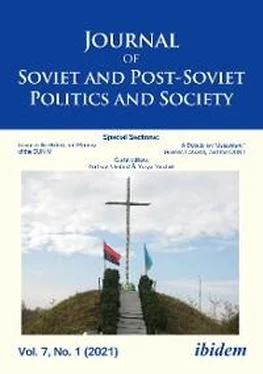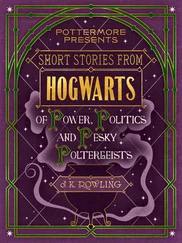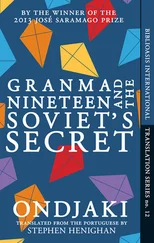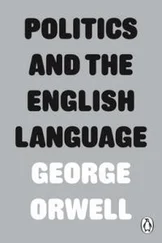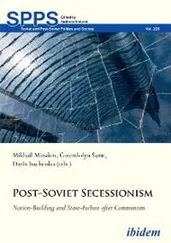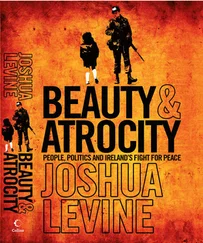The almost blatant violation of the USSR’s official legal norms by Soviet officers likely indicates that this was a common practice. The situation could not have been different—on the one hand, the Soviets were forced to maintain “the Soviet rule of law,” but on the other, they were expected to deliver immediate results in their fight against the guerrilla fighters and the underground movement. This meant that the number of individuals killed and arrested was expected to increase month by month. Reports sent to the headquarters were carefully read and thoroughly analyzed. Any decline in combat activity was immediately noticed and condemned. When faced with the choice whether to be “law-abiding and humanitarian” and expose oneself to the risk of being accused of ineptitude (or in the worst case—of supporting nationalists) or to break the law and expose oneself to the less likely risk of being accused of abuse, most people chose the latter option.
This behavior was welcomed by the Soviet leadership. On 10 January 1945, in Lviv, during a meeting of party activists and officials responsible for economic affairs in Lviv oblast’, the 1st secretary of the Communist Party of Ukraine Nikita Khrushchev explained the rationale for the repression in the following way:
They simply won’t respect us if we don’t take relevant measures, all members [of the resistance movement—GM] should be arrested, those who deserve it should be tried, or perhaps hanged, the remaining ones should be sent (read: deported—GM) and this will be the time when we will know that everything is OK and the people will know that we will take a hundred in exchange for a single individual... They need to be afraid of our revenge. 30
It should be noted that the Soviets were aware that this type of behavior discouraged the local population from supporting the communist rule. Moreover, the local residents likely had the feeling that they were under occupation. This is why, at least from 1945, the Soviets tried to reduce the scale of lawlessness and abuse in order to win over a portion of residents of Volhynia and Galicia and engage them in the fight against the OUN-B and the UPA.
Although in 1944–45, the Soviets did not manage to eliminate the guerrilla movement, they did force the Ukrainian leadership to disband the bigger units. In the end, in 1946 the leadership of the OUN and the UPA decided to abandon the “insurgent-guerrilla fight against the superior strength of the communist regime” 31and switch to deep conspiracy. The authorities continued to fight these small groups of underground activists until the mid-1950s.
In 1944–45, the activity of the OUN-B and the UPA in the USSR was at its most intense. Over that period, according to Soviet statistics, the Ukrainian guerrilla movement carried out 6,600 armed operations. The strength of the UPA is confirmed by the fact that its units were capable of waging regular battles with the NKVD Internal Troops. According to official information, in 1944–45 the Soviets carried out 39,773 “chekist-military” operations against the OUN and the UPA. They killed 103,313 members of the underground movement and guerrilla fighters, detained 110,785 individuals, and 50,058 members of the OUN and the UPA emerged from the underground, having appeared before amnesty committees. In addition, 13,704 deserters and 83,284 individuals evading military service in the Red Army were arrested. These figures, plus the thirty thousand deported individuals, give a total of a staggering more than 390,000 people (it should be noted that around five million Ukrainians lived in the two regions). 32
There is no doubt that the NKVD troops delivered the Ukrainian underground movement and the guerrilla movement a series of heavy and painful blows. Operations carried out by the NKVD Internal Troops contributed to a reduction in the scale of activity of the guerrilla movement, and most importantly they offered some degree of protection to the government apparatus built by the communists. This is why the activity of the NKVD Internal Troops should be viewed as an important factor that facilitated the post-war Sovietization of western Ukraine.
However, what is shocking is the scale of the acts of repression which accompanied the actions of a purely anti-guerrilla nature. They affected nearly every family in the western oblasts of Ukraine.
There is no doubt that the Soviets applied the principle of collective responsibility, repressing thousands of innocent people, often with only a loose or non-existent connection to the nationalist underground. Such ruthless treatment of the inhabitants of Eastern Galicia and Volhynia was not a result of the cruel methods of combat used by the OUN and the UPA. The Soviet troops showed similar brutality during counter-guerrilla operations conducted at that time in the Baltic states, and even in Poland, where in July 1945, during the operation in the Augustów Forests, at least 592 local inhabitants were arbitrarily declared “bandits” and subsequently executed without trial. 33It should also be noted that the involvement of such large forces and resources in Galicia and Volhynia by the Soviet repressive apparatus contradicts the popular thesis about the lack of social support for the OUN and UPA. Certainly, the underground could not have survived for so long without the broad support of the local population, who saw it as the only force resisting communist violence.
This is why in these regions the memory of the Ukrainian Insurgent Army is the idealized memory of an organization fighting above all else for Ukraine’s independence. When in 1991 Ukraine declared independence, following the collapse of the USSR, honoring the memory of the UPA was allowed in private ceremonies and at the local government level. Following the Revolution of Dignity, pursuant to a special law passed by the Verkhovna Rada in 2015, the UPA was recognized as a pro-independence organization at the state level. It is worrying that the official narrative most frequently “omits” the dark pages in the history of this organization and the crimes it committed against the civilian population. However, it should be remembered that the underlying motivation behind such an attitude is closely bound up with the memory of Soviet crimes.
1This research was funded by the National Science Centre (Poland) (decision no. DEC-2012/06/M/HS3/00284).
2The following publications on the NKVD Internal Troops are worth mentioning: Vnutrennie voiska v Velikoi Otechestvennoi voine 1941–1945 gg. Dokumenty i materialy (Iuridicheskaia literatura, 1975); Ispytannye voinoi. Pogranichnie voiska (1939–1945 gg.) (Granitsa, 2008); T. Cariewskaja, A. Chmielarz, A. Paczkowski, E. Rosowska, and S. Rudnicki (eds.), Teczka specjalna J. W. Stalina. Raporty NKWD z Polski 1944-1946 (Instytut Studiów Politycznych PAN, Instytut Historyczny UW, Oficyna Wydawnicza RYTM, Archiwum Państwowe Federacji Rosyjskiej, 1998); “Osobye papky” Stalina i Molotova pro natsional’no-vyzvol’nu borot’bu v Zakhidniy Ukraini u 1944–1948 rr. Zbirnyk dokumentiv (Piramida, 2010); Grzegorz Motyka, Na białych Polaków obława. Wojska NKWD w walce z polskim podziemiem 1944–1953 (Wydawnictwo Literackie, 2014); and A. Kokurin, N. Petrov, and R. Pikhoia (eds.), Lubianka VChK–OGPU–NKVD–NKGB–MGB–MVD–KGB 1917–1960 . Spravochnik (Mezhdunarodnyi Fond Demokratiia, 1997).
3For more on this subject, see John-Paul Himka, “The Lviv Pogrom of 1941: The Germans, Ukrainian Nationalists, and the Carnival Crowd,” Canadian Slavonic Papers LIII, no. 2–4 (2011): 209–43; Dieter Pohl, Nationalsozialistische Judenverfolgung in Ostgalizien 1941–1944: Organisation und Durchführung eines staatlichen Massenverbrechens (Oldenbourg, 1997); and Dieter Pohl, “Anti-Jewish Pogroms in Western Ukraine,” Shared History—Divided Memory: Jews and Others in Soviet-Occupied Poland, 1939–1941 , ed. Elazar Barkan, Elizabeth A. Cole, and Kai Struve (Leipziger Universitätsverlag, 2007), 305–31.
Читать дальше
